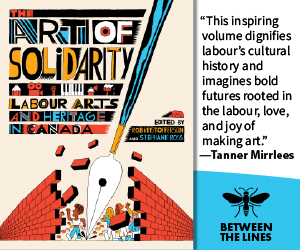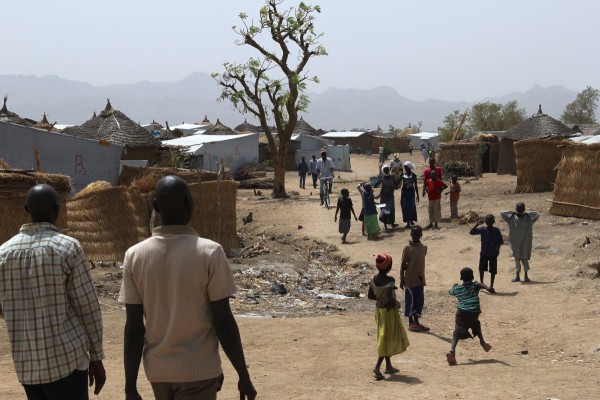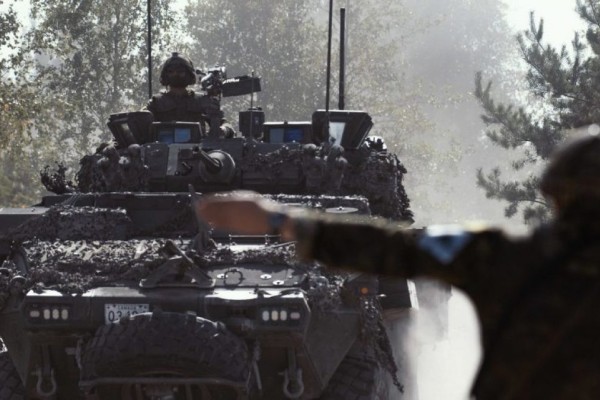Canada’s war problem
Why Canada shouldn’t buy F-35 fighter jets

F-35 in flight during tanker refuelling. Photo by David Drais/Lockheed Martin.
The F-35 is not a tool of peace or even of military defence. It is a stealth, offensive, nuclear-weapons-capable airplane designed for surprise attacks with the potential to intentionally or accidentally launch or escalate wars, including nuclear war. It is for attacking cities, not just other airplanes.
The F-35 is one of the weapons with the worst record of failing to perform as intended and requiring profoundly expensive repairs. Whereas older jets were made of aluminum, the F-35 is constructed from military composite materials with a stealth coating that emits highly toxic chemicals, particles, and fibres when set on fire. The chemicals used to put out and to practice putting out the fires can poison local water sources.
The ‘mighty’ stealth fighter also produces noise that causes negative health impacts and cognitive impairment in children living near the bases where pilots train to fly it. It renders housing near airports unsuitable for residential use, and its emissions are a major environmental polluter (the plane burns 22 gallons of fuel per minute).
Buying such a wasteful and destructive product in obedience to pressure from the United States makes Canada subservient to the war-mad American government. The F-35 requires US satellite communications, and Lockheed Martin repairs, upgrades, and maintenance. Canada will fight the aggressive foreign wars that the US wants it to, or no wars at all. Were the US to briefly halt the supply of aircraft tires and bombs to Saudi Arabia, the war on Yemen would effectively be ended. Yet the US keeps the supplies coming while hectoring about peace. Is that the relationship Canada wants?
The $19 billion to buy 88 F-35s jumps to $77 billion over a period of years just by adding in the cost of operating, maintaining, and eventually disposing of the planes, but yet additional costs can be counted on.
Why shouldn’t Canada buy any fighter jets?
The purpose of any fighter jet is to drop bombs and kill people (and only secondarily to star in Hollywood recruitment movies). Canada’s current stock of CF-18 warplanes has spent the last few decades bombing Iraq (1991), Serbia (1999), Libya (2011), Syria and Iraq (2014-2016), and flying provocative flights along Russia’s border (2014-2021). These operations have killed, injured, traumatized, rendered homeless, and made enemies of large numbers of people. None of these operations has benefitted those near it, those living in Canada, humanity, or the environment.
The F-35 (much like any other fighter jet) burns 5,600 litres of fuel an hour and may die after 2,100 hours—yet it is supposed to fly 8,000 hours, which would mean burning 44,800,000 litres of jet fuel. Jet fuel is worse for the climate than what an automobile burns. For what it’s worth, in 2020, 1,081 litres of gasoline were sold in Canada per registered vehicle, meaning that you could take 41,443 vehicles off the road for a year or give back one F-35 with equal benefit to the planet; or give back all 88 F-35s, which would equal taking 3,646,993 vehicles off the roads of Canada for a year—which is over 10 percent of the vehicles registered in this country.
What’s more, for $11 billion a year you could provide the world with clean drinking water. For $30 billion a year you could virtually end starvation. For $19 billion, Canada could build 575 elementary schools or construct 380,000 solar panels, or invest in the development of any number of emissions-reducing technologies to create good jobs and produce cleaner air.
Buying jets takes money away from addressing the crises of environmental collapse, nuclear proliferation, disease pandemics, homelessness, and poverty, and puts those funds into something that exacerbates these threats. An F-35 can provoke terrorist bombings or missile attacks but it can do nothing to stop them.

Why shouldn’t Canada buy any weapons?
Former Deputy Minister of National Defence Charles Nixon has argued that Canada does not need any fighter jets because it doesn’t face a credible threat and warplanes are not necessary to defend the country.
When we learn the history of warfare and of non-violent activism, we discover that even if Canada did face some credible threat, a military force would not be the best tool to address it. In fact, a growing military can create a credible threat where none existed in the first place. If Canada wants to generate global hostility in the way the US military has done, it need only continue imitating its southern neighbour.
It is important to overcome any illusion that militarized global policing and knight-in-shining-armour rescuing through humanitarian bombing or armed so-called peacekeeping is appreciated or democratic. Unarmed peacekeeping has not only proven more effective than the armed version (watch a film called Soldiers Without Guns for an introduction to unarmed peacekeeping), but is also appreciated by the people where it’s done, rather than only by the distant people in whose name it is undertaken.
The whole field of study—of nonviolent activism, diplomacy, international cooperation and law, disarmament, and unarmed civilian protection—is generally excluded from school textbooks and corporate news reports. We are supposed to know that Russia has not attacked Lithuania, Latvia, and Estonia because they are members of NATO, but not to know that those countries kicked out the Soviet military using less weaponry that your average American brings on a shopping trip—in fact, they used no weaponry at all. Why isn’t something that strange and dramatic a piece of common knowledge?
Why shouldn’t Canada sell any weapons?
Weapons dealing is a funny racket. In fact, most weapons come from a tiny number of countries. Canada is not one of them, but it is moving close to entering their ranks. Canada is the 16th-biggest weapons exporter in the world. Of the 15 bigger ones, 13 are allies of Canada and the US. Some of the oppressive governments and likely future enemies that Canada has sold weapons to in recent years include Afghanistan, Angola, Bahrain, Bangladesh, Burkina Faso, Egypt, Jordan, Kazakhstan, Oman, Qatar, Saudi Arabia, Thailand, Turkey, Turkmenistan, the United Arab Emirates, Uzbekistan, and Vietnam.
Aping the United States on a much smaller scale, Canada is doing its bit in the fight for democracy by making sure its enemies have plenty of deadly weapons. The Saudi Arabia-led war on Yemen has produced over 10 times the casualties as the war in Ukraine, despite the conflict receiving well below 10 percent of the media coverage.
Canada is itself the 13th-biggest military spender in the world, and 10 of the 12 bigger ones are allies. On a per capita basis, Canada ranks 22nd in military spending, and each of the 21 nations above us are allies. Canada is also the 21st biggest importer of US weapons, and all of ones are allies. However, sadly Canada is only the 131st biggest recipient of US military “aid”. This seems like a bad relationship. Perhaps an international divorce lawyer can be found.

Is Canada a puppet?
Canada participates in numerous US-led wars and coups. Usually Canada’s role is so minor that one cannot imagine its removal making much of a difference, except that the principle impact is in fact one of propaganda. The US is a bit less of a rogue for every co-conspiring junior partner it drags along. Canada is a fairly reliable participant, and one that boosts the use of both NATO and the United Nations as cover for criminal aggression.
In the US, traditional justifications for war are overwhelmingly dominant in motivating the largest portion of the population that supports any conflict, with humanitarian fantasies playing a minor role. In Canada, the humanitarian claims seem to be required by a slightly larger percentage of the population, and Canada has developed those claims accordingly, making itself a leading promoter of peacekeeping as a euphemism for war-making, and of doctrines like the “responsibility to protect.”
Canada participated in the war in Afghanistan for 13 years, but got out before many other countries did. We did the same in Iraq, albeit on a tiny scale. Canada has been a leader on some treaties like that on landmines (the Ottawa Treaty), but a holdout on others, such as that on the prohibition of nuclear weapons. It’s not a member of any nuclear free zone, but it is a member of the International Criminal Court.
Canada is up against US influence, financial corruption, labour unions lobbying for weapons jobs, and the influence of corporate media. Oddly, Canada uses nationalism to generate support for participation in US-led adventurism abroad. Perhaps it is the tradition of having participated in so many British wars that makes this seem normal.
Some of us admire Canada for having not fought a bloody revolution against Britain, but we’re still waiting for it to develop a non-violent movement for independence.
What should Canada do?
Robin Williams called Canada “a really nice apartment over a meth lab.” The fumes are rising and winning. Canada can’t move, but it can open some windows. It can also have some serious talks with its downstairs neighbour about how it’s hurting itself.
Some of us like to remember what a good neighbour Canada has been in the past, and what a bad one the US has been. Six years after the British arrived on the shores of North America, they hired mercenaries to attack the French in Acadia—the future US attacking the future Canada again in 1690, 1711, 1755, 1758, 1775, and 1812, while Canada has offered refuge to the enslaved and to those drafted into the US military (albeit less so in recent years).
But a good neighbour doesn’t obey an out-of-control addict. A good neighbour recommends a different course and teaches by example. We are in desperate need of global cooperation and investment in the environment, disarmament, refugee aid, and poverty reduction. Military spending and war are the main impediments to cooperation, to the rule of law, to the elimination of bigotry and hatred, to the ending of government secrecy and surveillance, and to the reduction and elimination of the risk of nuclear annihilation.
If a justifiable war were imaginable, it would still be impossible to justify the damage done by keeping around the institution and business of war, year in and year out. Canada should not host CANSEC, the largest weapons fair in North America. We should take a different tact, and host the biggest non-violent, unarmed peacemaking conference, living up to our lofty self-imagine and setting an example for the world’s leading economies to follow.
David Swanson is an author, activist, journalist, and radio host. He is executive director of WorldBeyondWar.org and campaign coordinator for RootsAction.org. Follow him on Twitter @davidcnswanson.










